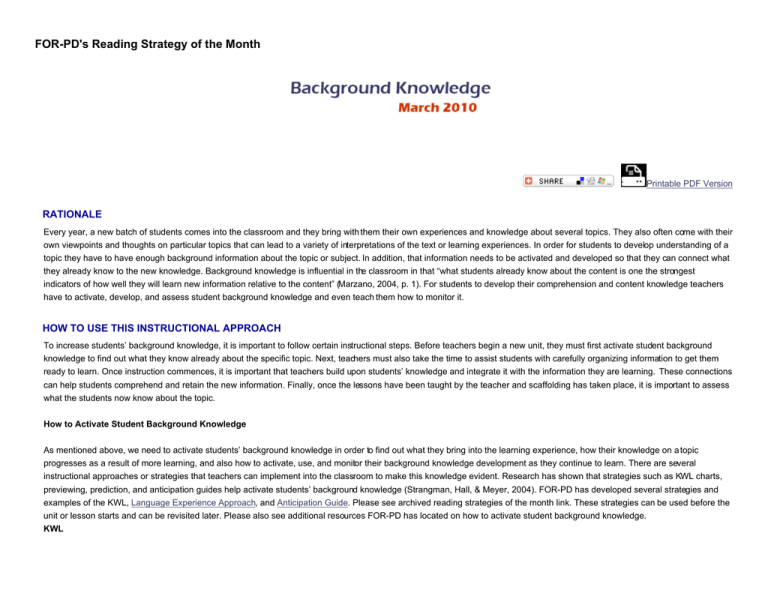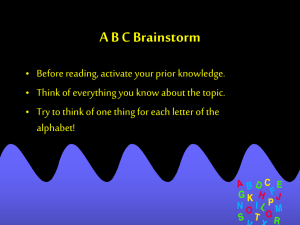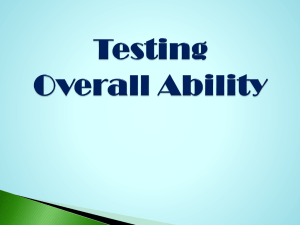
FOR-PD's Reading Strategy of the Month
Printable PDF Version
RATIONALE
Every year, a new batch of students comes into the classroom and they bring with them their own experiences and knowledge about several topics. They also often come with their
own viewpoints and thoughts on particular topics that can lead to a variety of interpretations of the text or learning experiences. In order for students to develop understanding of a
topic they have to have enough background information about the topic or subject. In addition, that information needs to be activated and developed so that they can connect what
they already know to the new knowledge. Background knowledge is influential in the classroom in that “what students already know about the content is one the strongest
indicators of how well they will learn new information relative to the content” (Marzano, 2004, p. 1). For students to develop their comprehension and content knowledge teachers
have to activate, develop, and assess student background knowledge and even teach them how to monitor it.
HOW TO USE THIS INSTRUCTIONAL APPROACH
To increase students’ background knowledge, it is important to follow certain instructional steps. Before teachers begin a new unit, they must first activate student background
knowledge to find out what they know already about the specific topic. Next, teachers must also take the time to assist students with carefully organizing information to get them
ready to learn. Once instruction commences, it is important that teachers build upon students’ knowledge and integrate it with the information they are learning. These connections
can help students comprehend and retain the new information. Finally, once the lessons have been taught by the teacher and scaffolding has taken place, it is important to assess
what the students now know about the topic.
How to Activate Student Background Knowledge
As mentioned above, we need to activate students’ background knowledge in order to find out what they bring into the learning experience, how their knowledge on a topic
progresses as a result of more learning, and also how to activate, use, and monitor their background knowledge development as they continue to learn. There are several
instructional approaches or strategies that teachers can implement into the classroom to make this knowledge evident. Research has shown that strategies such as KWL charts,
previewing, prediction, and anticipation guides help activate students’ background knowledge (Strangman, Hall, & Meyer, 2004). FOR-PD has developed several strategies and
examples of the KWL, Language Experience Approach, and Anticipation Guide. Please see archived reading strategies of the month link. These strategies can be used before the
unit or lesson starts and can be revisited later. Please also see additional resources FOR-PD has located on how to activate student background knowledge.
KWL
KWL (Know/Want/Learned) Charts
http://www.eed.state.ak.us/tls/Frameworks/sstudies/part4a15.htm
Topics in Assessment for English Language Learners
http://www.unm.edu/~devalenz/593F02/kwlspan.html
LEA
Creating a Language Experience Story
http://www.youtube.com/watch?v=QjeR5IKtrXI
How to Build Student Background Knowledge
Research has shown that direct instruction as well as reflecting and recording information during or after reading builds background knowledge. Building students’ knowledge is an
important instructional step for increasing reader comprehension. By scaffolding instruction, students are able to understand new information while incorporating it with prior
knowledge. Such strategies as Prediction Wheel, Think Aloud, INSERT, and Making Connections
aid in building student background knowledge. Please see FOR-PD archived reading strategies of the month link. Please also see additional resources FOR-PD has located on
how to activate student build student background knowledge in a junior high classroom.
Think Aloud Demonstration
http://www.teachertube.com/viewVideo.php?video_id=116101
ASSESSMENT
How to Assess Student Background Knowledge
While activating and building knowledge are important, assessing students’ background knowledge is also important. There are a few ways that a teacher can assess student
background knowledge; for example, teachers can use informal assessment, questioning, student conferences, or specific strategies such as: anticipation guides, opinionaires,
and cloze passages (Fisher & Frey, 2009). Several of the above mentioned strategies can also be used after reading.
Anticipation guides can be used both for activation of background knowledge and for assessment. Students can first respond to statements about a topic prior to the unit or
introduction of topic, and then revisit their thinking again after the completion of the unit or topic. Teachers can also require that students include explanations to support the
decisions they made about the topic statements (Fisher & Frey, 2009). Please see FOR-PD example of an anticipation guide for a high school chemistry class.
Opinionaires are another form of informal assessment whereas students respond to a statement based on areas of opinion using the following scale of agreement levels: i.e.,
strongly agree, agree, disagree, and strongly disagree. This form of assessment invites students to connect their knowledge of a topic with their own thoughts and opinions and
present a rationale for the decisions they made on the topic. Please see FOR-PD example of an opinionaire for a high school biology class.
The Cloze procedure can be used in varied ways for instructional and diagnostic purposes. Cloze
passages are another way to assess student knowledge of a topic. To construct cloze passages, omit every fifth word. Select a critical passage of 250 words; leave the first and
last sentence intact. Cloze can also be used to help students focus on certain types of words (e.g., adjectives, connectives, content-specific words, etc.). Teachers can provide
choices for each deleted word or ask the students to write the word they think fits. As students are using the cloze procedure, they are hypothesizing (and predicting) based on
their overall knowledge of the world around them, the content of the passage, their topic-specific knowledge, and their knowledge of English.
Cloze Passage
http://www.testyourenglish.net/english-online/cloze-reading/clozetest-4.html
RESOURCES
Connect Students’ Background Knowledge to Content in the ELL Classroom
http://www.readingrockets.org/articles/20827
This article details how to help ELL students by activating their background knowledge.
Use Summer Fun to Build Background Knowledge
http://www.colorincolorado.org/article/16254
A step by step guide on how parents can use summer activities to build readers’ background knowledge.
REFERENCES
Marzano, R. J. (2004). Building background knowledge for academic achievement: Research on what works in schools. Alexandria, VA: Association for Supervision and
Curriculum Development.
Fisher, D. & Frey, N. (2009). Background knowledge: The missing piece of the comprehension puzzle. Portsmouth, NH: Heinemann
Strangman, N., Hall, T., & Meyer, A. (2004). Background knowledge with UDL.
Wakefield, MA: National Center on Accessing the General Curriculum. Retrieved February 2nd from http://www.cast.org/publications/ncac/ncac_backknowledgeudl.html.
Go to Strategy of the Month Archive.
Go to Adobe PDF instruction page.
About | Registration | Participants | Facilitators | Educators | Parents | Resources | Help Desk | eStore | Contact | Search | Site Map
For comments and suggestions, please contact us at forpd@mail.ucf.edu or 407-207-7296.
© Copyright 2003-2007 for FOR-PD by the Florida
Department of Education and the University of Central Florida. All rights reserved.


